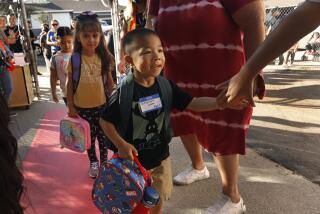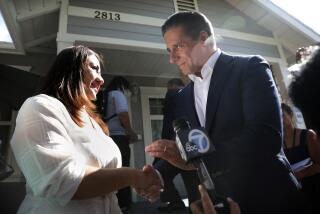Are California kids actually learning anything since coronavirus closed their schools?

- Share via
Some students in the Los Angeles Unified School District are receiving their lessons and homework assignments via the internet. Others, including those without access to broadband, are watching educational TV on PBS and filling out the coordinated assignments that go with the programs. Some students might be doing both.
And some, parents say, aren’t getting anything but a few worksheets.
The reality is that L.A. Unified had only about three weeks to plan as the coronavirus was spreading through California. And now, just a few days after closing its campuses, the district at least has a coordinated plan in place for continuing the education of its students. That’s more than many school districts in the state and across the nation can say. There’s a lot of educational floundering going on. Early reports suggest big variations in how energetically and effectively individual teachers in California and nationally are instructing their remote students. Some are naturals at it and have created their own websites; others are awaiting help before they provide actual instruction.
L.A. Unified parents might be frustrated, but they also need to cut the district some slack; it’s not easy on such short notice to get an operation this unwieldy — and utterly unprecedented — under way.
Disconcertingly, the state shows fewer signs of having planned for this in advance than the district. The federal government hasn’t been supplying much help, either, leaving schools nationwide in a quandary. Both need to step up and provide more specific assistance. The education of about 41 million K-12 students whose schools have been closed — of the 51 million in the nation — is at stake.
One of the major challenges is providing equal educational opportunity to all. Right now, most schools with large numbers of disadvantaged students are finding it hard to get those kids both the education and other services they need. Disadvantaged students — who make up more than 80% of L.A. Unified students — are less likely to have internet access at home or parents who can tutor them.
L.A. Unified’s partnership with PBS is innovative and gives students lessons that they otherwise wouldn’t receive during this period. It is already being picked up by Bay Area schools as well. But there’s no use pretending that this provides students with the same level of learning they’d get directly from teachers. Late last week, Gov. Gavin Newsom called for state funding to expand broadband to more families so they can take part in the fuller learning process, a good first step if a somewhat late one.
The largest school district in Kentucky decided against moving to online learning, fearing that it would run afoul of educational equity laws because it wouldn’t provide the same level of services to all students. Others have hesitated because the U.S. Education Department has said schools still must abide by laws that require equal access to learning for students with disabilities, which in some cases could mean that local districts would need to provide sophisticated equipment at home.
Of course, as this crisis continues, school districts must make an intensive effort to meet the educational needs of low-income and special education students, homeless children and those facing other obstacles. Schools are unlikely to reopen in a couple of weeks. Right now, without delay, they need to provide what education they can. It might not reach all students right away, but these aren’t normal times and it makes no sense to have an entire population of students go uneducated while we search for the best possible solutions for those who need extra assistance.
The California Education Department has issued a lengthy but largely disappointing set of guidelines to public schools about remote learning that raises more questions than it answers. Advising districts to set goals, help teachers and consider their resources and educational equity is pretty much telling them what they already know; it doesn’t tell them how to do those things. How about creating and providing online courses tied to the state’s standards, including for English learners, and taught by master teachers? Any school district could then use them. The state also could work on bringing the PBS project statewide.
In addition, Newsom should ensure that high school seniors who already have been accepted to the University of California and/or California State University will be allowed to attend, even if they’re missing a couple of credits or if their coursework through the end of the year doesn’t measure up to usual standards. If a little more remedial help is needed at college, so be it. We certainly hope colleges will reopen in the fall.
Without taking over local schools, the state and federal governments should be far more proactive in helping them figure out this unprecedented situation and then holding them responsible for providing as good an education as possible to as many students as possible.
More to Read
A cure for the common opinion
Get thought-provoking perspectives with our weekly newsletter.
You may occasionally receive promotional content from the Los Angeles Times.









